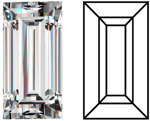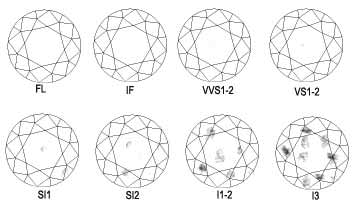Lloyds Family Jewellery Diamond Guide
Diamonds at Lloyds
Our diamonds are 100% natural, with no enhancements, fillers or treatments. Our gemstones are earth mined and none synthetic. Every one of our diamonds and gemstones are conflict free, responsibly sourced adhering to united nations resolutions.
We keep our diamond grading simple, by providing what we feel offers the best compromise between size, colour, clarity and cost. Taking the stress out of jewellery shopping and letting you focus on your perfect design.
Diamond Grades Explained
At Lloyds Family Jewellery we offer a variety of diamond grades readily available. You may want to read up about the 4 C's on this page to get a better understanding of the grades below. 
Colour: G, Clarity: SI1
Offered in the majority of our 18k jewellery, these diamonds are G colour, with a clarity of SI1 which is the high end of 'slightly included', this means the diamond has slight inclusions visible to a trained eye under 10x magnification and unlikely to have inclusions visible to the naked eye. G colour is a high colour grade classed as near colourless, colour tint is generally not noticeable to the naked eye. We also use SI2 diamonds (this will be stated on the item description) which are slightly more included with a slightly higher chance of noticing some inclusions when looking very closely, these diamonds are still bright and offer exceptional value.
Colour: H, Clarity: I1 and I2
H colour is in the near colourless range, there might be a slight colour tint when comparing to higher colour grades but difficult to notice in normal lighting. I1 refers to the clarity, this is the high/clear end of 'included', this means the diamond has inclusions visible under 10x magnification and may have some inclusions noticeable to the naked eye when looking very closely (more likely to notice with larger diamonds) This grade offers good value and is generally provided with 9k gold items with smaller stones which make it harder to notice inclusions. Some pieces feature I2 clarity diamonds, this is the lower end of included meaning inclusions are noticeable to the naked eye and may have a more cloudy appearance when comparing to higher grades, this is less noticeable on small diamonds. Some items with lots of small diamonds may have a mix of I1 and I2.
Colour: G, Clarity: VS
Select items are supplied with high grade diamonds of G colour VS clarity, these are always used in 18k or platinum pieces and command higher prices. Inclusions are very slight and difficult to find even under magnification.
Diamonds Explained
Diamonds are a rare composition of pure crystallized carbon, formed under extremely high heat and pressure deep within the earth. They are aged between 1 and 3.3 billion years old (up to 75% of the earths age) and are brought close to the surface by volcanic eruptions. Most Diamonds contain impurities, not defects but better to think of these as birthmarks which makes each diamond unique, most impurities can not be seen with the naked eye. Diamonds are the hardest natural substance on earth, the name diamond comes from the ancient Greek Adámas meaning "unbreakable". Due to their incredible optical properties and hardness, diamonds are the most prized of all gemstones.
The Four C's
The best way of grading a diamond is by using the four C's as shown below, then combining these to give the grade and to help calculate the value. Diamond pricing is a complicated process and takes many other factors into account as well as the four C's. The four C's were established by the Gemmological Institute of America (GIA) and has since become the international standard for diamond grading.

Staff at Lloyds Family Jewellery are trained by GIA and are certified with the Diamond Essentials certificate.
Diamond Cut
Cut has a big impact on the beauty of diamonds, the word cut has several meanings when it comes to diamonds. The cut of a diamond does not only mean its shape (round brilliant, princess, oval, cushion, etc.) but also addresses the proportions, symmetry and polish of the diamond.
The cut determines the diamond's brilliance (white flashes) and fire (light split into all colours in the spectrum, red, yellow, green etc.). A properly cut diamond will reflect the light that enters the diamond and return it through the table to produce the much desired sparkle. The angles should be within the correct parameters to optimize the reflection of light back to the eye. The proportions, polish and symmetry are graded from excellent to poor and together make up the diamonds cut grade (the best being triple excellent). You will only find cut grade on comprehensive diamond reports for a single diamond.
Diamonds can be cut in various shapes including;


Baguette Cut: The baguette cut diamond is often forgotten as it is mainly used as an accent stone. It has a simple step cut, not to be confused with the Emerald cut. Unlike the Emerald cut it has pointed edges and is generally used in channel settings. Eternity rings featuring Baguette diamonds in a channel settings are very popular as well as complementing centre stones by being set on shoulders, tapered baguettes are also popular for shoulder settings.


Diamond Colour
Diamonds are not only colourless as many people think, most diamonds have tones of faint yellow or brown, the higher a diamond is towards the top of the colour scale, the more rare the diamond becomes and therefore more valuable. Diamonds can also be found in a variety of colours and hues such as Pink, Red, Blue and Green, these are known as fancy colours and are graded separately from the usual colour scale. Fancy diamonds are much rarer than the more common and sought after colourless diamonds. With 'white' diamonds the less colour the more valuable the diamond becomes, faint signs of yellow or brown can decrease value. Colours are graded in letters from D meaning colourless all the way to Z meaning light yellow or brown. The scale does not include the letters A, B or C, as to not confuse the scale with older, less accurate methods of grading.


Diamond Clarity
This indicates how clear the diamond is from inclusions, this plays a big part in determining value. Inclusions may be; dark carbon spots, white crystal particles (which can cluster together to make 'clouds') and internal or external fractures. Man made defects by the cutter can also be taken into account such as polish lines or extra facets which may have been placed there to remove an inclusion. Diamonds can also be damaged, remember diamonds are extremely hard but will chip or fracture if struck hard enough. The grades for Clarity are shown below.


Common Grades:
F: Flawless
IF: Internally Flawless
VVS: Very Very Slightly Included
VS: Very Slightly Included
SI: Slightly included
I1: Included 1
I2: Included 2
I3: Included 3
The number 1 or 2 can also be added; this represents the extent of inclusions, 1 being the cleanest. Number 3 is reserved for I grade diamonds, this represents a diamond with lots of inclusions which would be more noticeable to the naked eye.
Diamond Weight
Most people think of this as being the diamonds size, when in fact it is the weight. When looking at a single diamond; the heavier the carat weight, the rarer the diamond becomes and therefor more valuable (assuming all other grading criteria are equal). Carat/s is usually abbreviated to ct or cts. One carat equals 1/5th of a gram, in other words... there are 5 carats in 1 gram. You may also have heard a diamond referred to in points. There are 100 points in a 1.00ct diamond, therefore a quarter carat or 0.25ct diamond has 25 points.
Carat weight may also refer to the total weight of diamonds in a piece of jewellery. A diamond ring may consist of 10x 0.10ct diamonds or 100x 0.01ct diamonds and both would have a carat weight of 1.00ct (one carat) however the item with 10 diamonds would generally be more expensive, this is due to the fact that 10 larger diamonds are rarer than the equivalant weight of 100 tiny diamonds which makes them more valuable.
Here's where is can get complicated. During the diamond cutting process the cutter wants to get the heaviest diamond out of a rough stone, however this can come at the cost of lowering the cut grade. If a diamond is too deep, this will increase carat weight but results in a loss of brilliance due to light leakage. Diamond cutters have to compromise between finishing with the heaviest weight possible while still keeping good proportions. This is why you can have two diamonds of the same weight but one can be bigger than the other. A well cut 0.90ct diamond could have the same width as a poorly cut 1.00ct diamond (this is known as spread). These two diamonds however could be of equal value, which would you go for? Heavier weight or a higher cut grade.
Common Weights
0.25ct (quarter carat)
0.50ct (half carat)
0.75ct (three quarter carat)
1.00ct (1 carat)
Most diamonds sold in jewellery are under 1.00ct, although diamonds can reach incredible sizes; the largest ever rough gem quality diamond was the cullinan diamond found at the Premier Mine, South Africa. This incredible diamond weighed 3,106.75cts, the diamond was split to create nine pieces, the largest piece is a pear cut diamond weighing 530.4cts and named the Great Star of Africa. It now resides in the Crown Jewels of England in the Royal Sceptre.
The word "carat" comes from the ancient practice in India where diamonds were first thought to have been discovered and traded, they measuring diamond weights with the one thing in nature that is both small and the most consistent in weight -- the carob seed. Thus the name "carat" evolved in the English language, which is still equivalent to approximately the weight of one carob seed. Carat weights are very precise, they are weighed to a thousandth of a carat then rounded off to the nearest hundred.
Diamond size chart: sizes are a guide only. Actual diamonds may differ depending on proportions.
Round Cut |
||
| Millimeters Approx | Carat weight | Points |
| 1.0 | 0.005 | 0.5 |
| 1.3 | 0.01 | 1 |
| 1.5 | 0.015 | 1.5 |
| 1.7 | 0.02 | 2 |
| 1.8 | 0.025 | 2.5 |
| 2.0 | 0.03 | 3 |
| 2.1 | 0.035 | 3.5 |
| 2.2 | 0.04 | 4 |
| 2.4 | 0.05 | 5 |
| 2.5 | 0.06 | 6 |
| 2.7 | 0.07 | 7 |
| 2.8 | 0.08 | 8 |
| 2.9 | 0.09 | 9 |
| 3.0 | 0.10 | 10 |
| 3.1 | 0.11 | 11 |
| 3.2 | 0.12 | 12 |
| 3.3 | 0.14 | 14 |
| 3.4 | 0.15 | 15 |
| 3.5 | 0.16 | 16 |
| 3.6 | 0.17 | 17 |
| 3.7 | 0.18 | 18 |
| 3.8 | 0.20 | 20 |
| 3.9 | 0.22 | 22 |
| 4.0 | 0.25 | 25 |
| 4.2 | 0.30 | 30 |
| 4.4 | 0.33 | 33 |
| 4.5 | 0.35 | 35 |
| 4.6 | 0.38 | 38 |
| 4.8 | 0.40 | 40 |
| 5.0 | 0.50 | 50 |
| 5.4 | 0.60 | 60 |
| 5.5 | 0.63 | 63 |
| 5.6 | 0.65 | 65 |
| 6.0 | 0.75 | 75 |
| 6.4 | 0.95 | 95 |
| 6.6 | 1.00 | 100 |
| 6.8 | 1.17 | 117 |
| 7.0 | 1.25 | 125 |
| 7.2 | 1.33 | 133 |
| 7.5 | 1.55 | 155 |
| 7.8 | 1.75 | 175 |
| 8.0 | 2.00 | 200 |
| 8.4 | 2.15 | 215 |
| 8.6 | 2.25 | 225 |
| 9.0 | 2.75 | 275 |
| 9.4 | 3.00 | 300 |
| 9.6 | 3.15 | 315 |
| 9.8 | 3.35 | 335 |
| 10.0 | 3.50 | 350 |
| 10.2 | 3.75 | 375 |
| 10.4 | 4.00 | 400 |
| 10.6 | 4.25 | 425 |
| 10.8 | 4.50 | 450 |
| 11.0 | 4.75 | 475 |
| 11.2 | 5.00 | 500 |
| 12.0 | 6.50 | 650 |
Oval Cut |
||
| Millimeters Approx | Carat weight | Points |
| 4 x 3 | 0.20 | 20 |
| 5 x 3 | 0.25 | 25 |
| 5 x 3.5 | 0.33 | 33 |
| 5 x 4 | 0.40 | 40 |
| 6 x 4 | 0.50 | 50 |
| 6.5 x 4.5 | 0.65 | 65 |
| 7 x 5 | 0.75 | 75 |
| 7.5 x 5.5 | 1.00 | 100 |
| 8 x 6 | 1.25 | 125 |
| 8.5 x 6.5 | 1.50 | 150 |
| 9 x 6 | 1.75 | 175 |
| 9 x 7 | 2.00 | 200 |
| 9.5 x 7.5 | 2.50 | 250 |
| 10 x 8 | 3.00 | 300 |
| 10 x 8.5 | 3.50 | 350 |
| 11 x 9 | 4.00 | 400 |
| 11 x 9.5 | 4.50 | 450 |
| 12 x 10 | 5.00 | 500 |
Marquise Cut |
||
| Millimeters Approx | Carat weight | Points |
| 3.5 x 1.5 | 0.07 | 7 |
| 4 x 2 | 0.10 | 10 |
| 5 x 2 | 0.20 | 20 |
| 5 x 3 | 0.22 | 22 |
| 5.5 x 2.5 | 0.25 | 25 |
| 6 x 3 | 0.30 | 30 |
| 7 x 3 | 0.35 | 35 |
| 7 x 3.5 | 0.38 | 38 |
| 7 x 4 | 0.40 | 40 |
| 8 x 4 | 0.50 | 50 |
| 8.5 x 4.5 | 0.65 | 65 |
| 9 x 4 | 0.70 | 70 |
| 9 x 4.5 | 0.75 | 75 |
| 9 x 5 | 0.80 | 80 |
| 9.5 x 4.5 | 0.85 | 85 |
| 10 x 4.75 | 1.00 | 100 |
| 10 x 5 | 1.25 | 125 |
| 11 x 5 | 1.50 | 150 |
| 11 x 5.5 | 1.65 | 165 |
| 12 x 6 | 2.00 | 200 |
| 13 x 5.5 | 2.50 | 250 |
| 13 x 6 | 2.65 | 265 |
| 14 x 6.5 | 2.87 | 287 |
| 14 x 7 | 3.00 | 300 |
| 15 x 7 | 3.75 | 375 |
| 16 x 8 | 4.50 | 450 |
| 18 x 9 | 7.00 | 700 |
| 20 x 10 | 10.00 | 1000 |
Princess Cut |
||
| Millimeters Approx | Carat weight | Points |
| 2.00 | 0.06 | 6 |
| 2.25 | 0.08 | 8 |
| 2.50 | 0.10 | 10 |
| 2.75 | 0.13 | 13 |
| 3.0 | 0.15 | 15 |
| 3.25 | 0.20 | 20 |
| 3.5 | 0.23 | 23 |
| 3.75 | 0.25 | 25 |
| 4.0 | 0.30 | 30 |
| 4.42 | 0.35 | 35 |
| 4.5 | 0.40 | 40 |
| 4.75 | 0.50 | 50 |
| 5.0 | 0.63 | 63 |
| 5.25 | 0.75 | 75 |
| 5.5 | 1.00 | 100 |
| 6.0 | 1.25 | 125 |
| 7.0 | 1.60 | 160 |
| 8.0 | 2.25 | 225 |
Emerald Cut |
||
| Millimeters Approx | Carat weight | Points |
| 4 x 3 | 0.20 | 20 |
| 5 x 3 | 0.25 | 25 |
| 6 x4 | 0.50 | 50 |
| 6.5 x 4.5 | 0.75 | 75 |
| 7 x 5 | 1.00 | 100 |
| 8 x 6 | 1.50 | 150 |
| 8.5 x 6.5 | 2.00 | 200 |
| 9 x 7 | 2.50 | 250 |
| 10 x 8 | 3.00 | 300 |
| 11 x 9 | 4.00 | 400 |
| 12 x 10 | 5.00 | 500 |
Pear Cut |
||
| Millimeters Approx | Carat weight | Points |
| 4 x 2 | 0.20 | 20 |
| 5 x 3 | 0.30 | 30 |
| 6 x 4 | 0.50 | 50 |
| 7 x 5 | 0.75 | 75 |
| 8 x 5 | 1.00 | 100 |
| 9 x 6 | 1.50 | 150 |
| 10 x 7 | 2.00 | 200 |
| 12 x 7 | 2.50 | 250 |
| 12 x 8 | 3.00 | 300 |
| 13 x 8 | 3.50 | 350 |
| 14 x 8 | 4.00 | 400 |
| 15 x 9 | 5.00 | 500 |
